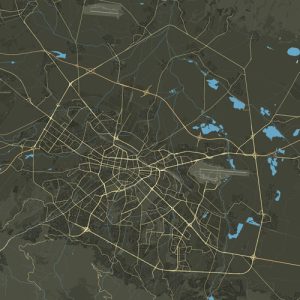Archaeological complex “Kaleto” consists of 4 levels. The first covers a parking lot with 30 spaces, a park with rock gardens and a fountain, administrative and exhibition premises. On the second level is located a newly built an amphitheater stage with 84 seats and a decorative colonnade.
On the third level there is an air-conditioned exhibition hall presenting the history of the fortress over the centuries. A model of a Roman fortress from the 2nd century is on display, showing the location of the buildings in it. Also on display are unique objects and remains from the various historical periods during which the fortress existed.
On the last level are the fortress ruins, preserved and exposed for visitors. Two routes are planned – one covers the interior of the fortress, and the other is bypassed and passes along the foundations of the fortress wall.
At the beginning of the bypass route, part of an additional fortification (proteichism), built in the IV-VI century period, has been preserved. There is a destroyed part of the fortress wall, which is a layer charred by fire. It is exposed to visitors in order to see the traces of the earliest settlement of the rock hill.
At the end of the detour route, the structure of the fortress wall stands out the most – you can see rows of quadri, cut and river stone. Also visible are the places where santrachi (thick, strong beams between the rows of stones) were built into the wall of the north tower for greater resistance.
70-century history is preserved in the “Kaleto” Archaeological Complex. The presence of all civilizations that inhabited the Bulgarian lands from the Stone-Copper Age to the Middle Ages is registered. This is due to the strategic location of the fortress. The river hill provides natural protection and is located at the intersection of major roads used from ancient times to the present day.
The “Kaleto” archaeological complex has preserved the traces of two consecutively existing fortified settlements from the end of the Stone – Copper Age and the Bronze Age, which were destroyed by natural fires. The numerous finds from this period testify that the settlement flourished as a craft center at that time.
One of the significant finds from the end of the Stone-Copper Age is the open “Sanctuary of the Tour”, which has no analogue in Europe. At a depth of nearly 4 m, a sacrificial altar was discovered with two symmetrically placed skulls of prehistoric wild cattle (Tur) and a stone bucrania.
Continuity of the sacred place through the ages is essential. An early Thracian temple was built on the remains of the “Sanctuary of the Tour” after 2,500 years. The ancient Thracians from the “Tribali” tribe inhabited the area until the 1st century, when the settlement along with all of Mysia was conquered by the Roman Empire.
In the center of the fortress, near the “Sanctuary of the Tour”, there are the remains of a Roman temple where gifts were offered to the gods. Numerous bronze coins from the time of the Roman Empire, bronze fibulae, belt ornaments, torkwa, and a silver laurel leaf have been found from this period.
Among the foundations of the Roman temple was discovered the only completely preserved coin of the emperor Alexander Severus, which was not in circulation and was given as a gift to the temple.
One of the most important finds from the Roman era is the bronze cast of an eagle discovered under the base of the fortress wall. This is one of the earliest images of this bird – a symbol of the Roman Empire, expressing power and strength.
Another valuable find is the discovered bronze key. Due to the strategic importance of the Roman fortress, archaeologists believe that it is the symbolic Key to the Northwest.
At the end of the 6th beginning of the 7th century, the Slavs settled in these places, and a little later the proto-Bulgarians. On the found ruins, they built their own settlement, which lasted from the 10th to the 11th century. The Old Bulgarian fortress and the settlement were captured in the 11th century by the Byzantine emperor Basil II. During the Byzantine rule, the fortress was used for observation and defense purposes.
The fortress was used again during the Second Bulgarian State. According to many local legends, some of the last battles of Tsar Ivan Shishman were fought in this area and along the Iskar gorge. The Kaleto fortress, called Dermanitsa (Dermanitsa), took part in the defense against the advancing Ottomans. Its final destruction and abandonment took place in the 14th century during the conquest of the Bulgarian lands by the Ottoman Turks.
Location
Archaeological complex “Kaleto” is located in northwestern Bulgaria, at the entrance to the town of Mezdra (Vratsa region). It is located on a rocky hill overhanging the left bank of the Iskar River.
Transportation
Archaeological complex “Kaleto” is located in close proximity to the international road E-79, 90 km from the city of Sofia and 15 km from the city of Vratsa. The site is located near the Mezdra station, which is an important railway junction through which most of the main train lines pass.
Work time:
Winter opening hours: Monday – Sunday: 08:00 – 17:00
Summer opening hours: Monday – Sunday 09:00 – 18:00
Entrance fees:
Regular ticket: BGN 3.
Reduced: BGN 1.5.
Talk: BGN 5.

